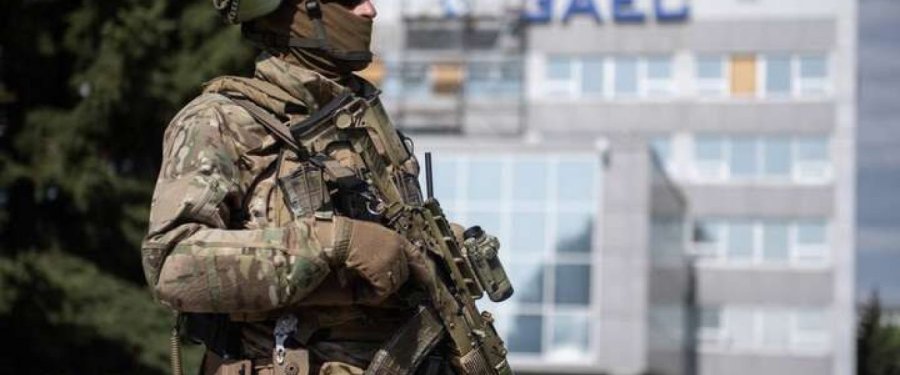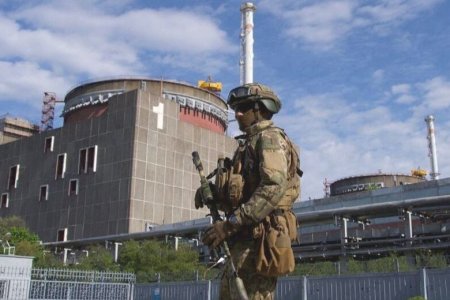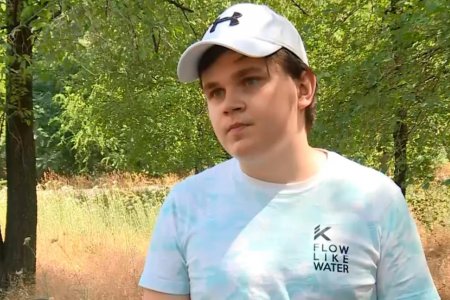
Update:
Enerhoatom has reported further shelling of Europe’s largest nuclear power plant in the evening of 6 August, with a missile landing near a container storing used nuclear fuel and damaging three meters for monitoring radiation. One of the staff of the plant received shrapnel injuries and has been hospitalized. Enerhoatom reports that all the Russians illegally occupying the plant had hidden in bunkers, with this clearly suggesting a planned attack. The Ukrainian nuclear power agency stated on 6 August that it believes this third shelling of a nuclear power plant is aimed at cutting Ukraine’s power supplies to the south of the country. Since Russia’s seizure of the plant in March 2022, there have been Russian military and specialists present, but the plant has continued to be run by the Ukrainian team and the energy has continued to flow to the Ukrainian grid. It looks as though Russia is using such criminally dangerous methods to try to change this. Russia, once again, has claimed that Ukraine is bombing its own nuclear power plant, and even asserted that it did so with ‘a cluster bomb’. It does not explain how it could do so from Russian-occupied territory.
************************************
Rafael Mariano Grossi, Director General of the International Atomic Energy Agency (IAEA) issued a statement on 6 August, warning that the shelling of the Zaporizhzhia Nuclear Power Plant on 5 August “underlines the very real risk of a nuclear disaster”. That danger has been real since early March when the Russian invaders first shelled the plant, before seizing control of it, and has been escalating over recent weeks with mounting abductions of the Ukrainian personnel.
Russia is, of course, claiming that Ukraine was behind the shelling. While IAEA is careful to urge “all parties” to exercise caution, and does not name Russia as behind the violent acts near the plant and against its staff, Josep Borrell, speaking for the European Union, was less circumspect. He wrote on 6 August, that “the EU condemns Russia’s military activities around Zaporizhzhia nuclear power plant. This is a serious and irresponsible breach of nuclear safety rules and another example of Russia’s disregard for international norms. IAEA must gain access.”
Ukraine’s Enerhoatom accuses Russia of seeking to destroy the infrastructure at the plant, in order to damage the transmission lines used to transport electricity to the Ukrainian grid, and thus disconnect it from Ukraine’s power system. The Ukrainian atomic energy agency reported on Friday that Russians in (the occupied) city of Enerhodar had shelled in the direction of the Zaporizhzhia plant twice. The first attack had damaged a high-voltage line. The second involved strikes “near one of the blocs, containing a nuclear reactor”. Enerhoatom reports that the strikes seriously damaged a nitrogen-oxygen unit and an auxiliary block, and warns of the risk of a leakage of hydrogen or radioactive particles.
It would be easier to believe Russia’s claim that Ukraine is shelling its own nuclear power plant and endangering the lives of its own citizens, had Russia not sharply escalated its abductions of Ukrainian personnel at the plant, and amassed weapons and military technology on its territory.
As of late 19 July, three safety officials from the plant had been abducted in the space of a week, with at least two more reported abducted two days later.
The Head of Enerhoatom warned on 13 July, that the Russians were cynically using the largest nuclear power plant in Europe for storing weapons and for launching missiles used to shell Nikopol and other targets. On 20 July, Enerhoatom reported chilling details, saying that the Russian military were demanding that the plant’s administration open up the machinery halls to the first, second and third of the plant’s reactors, enabling the Russians to store their arsenal there. “That seems safer to the invaders as they’re absolutely terrified of ‘gifts’ from the Ukrainian Armed Forces.”
By storing their military vehicles, as well as weapons, etc., Enerhoatom warned, they would be blocking the fire engines that would otherwise be deployed to prevent catastrophic fires at the nuclear plant. The Russian invaders were, in short, violating all norms and requirements for nuclear safety.
That Russia is so recklessly exploiting the fact that Ukraine cannot return fire at a nuclear power plant was acknowledged on 5 August by the UK’s Ministry of Defence which wrote that, while Russia’s intentions regarding the plant remained unclear, “the actions they have undertaken at the facility have likely undermined the security and safety of the plant’s normal operations. Russian forces are probably operating in the regions adjacent to the power station and have used artillery units based in these areas to target Ukrainian territory on the western bank of the Dnipro river.” It suggests that Russia is “utilising the protected status of the nuclear power plant to reduce the risk to their equipment and personnel from overnight Ukrainian attacks.”
Back on 15 July, Petro Kotin, President of Enerhoatom, warned that the Russians had used missile launchers held at the plant to shell the city of Nikopol and expressed frustration at the lack of pressure being brought to bear on Russia over its armed occupation of a nuclear power plant. He accused IAEA then of being far too passive.
At least verbally that has now changed. On 3 August, the IAEA Chief warned, in an interview to Associated Press, that the Zaporizhzhia nuclear power plant (the largest in Europe), “is completely out of control”, Grossi called on both Ukraine and Russia to allow experts to visit the complex and help avert a nuclear accident. He said that “every principle of nuclear safety has been violated” at the plant”, adding that “What is at stake is extremely serious and extremely grave and dangerous.”
It is likely that Russia will try to force an IAEA delegation to visit ‘from Russia’. It has used this type of unacceptable demand as a method of blocking visits from, among others, UNESCO, to occupied Crimea. Grossi suggests, however, that the stakes this time are simply too great and that there is an imperative need to get an IAEA team to the plant. He believes that the IAEA would “by its presence, be a deterrent to any act of violence against this nuclear power plant,”
After the shelling on 5 August, Rossi issued the above-mentioned statement which certainly pulls no punches regarding the real and immediate “risk of a nuclear disaster”. He points out that “any military firepower directed at or from the facility would amount to playing with fire, with potentially catastrophic consequences.”
Russia is using the Ukrainian population and that of neighbouring countries as human shields. This is evidenced by its stockpiling of weapons at a nuclear power plant, its firing of missiles from it and, it would appear, by its shelling of the plant. It is very much to be hoped that it will agree to some kind of compromise to enable an IAEA investigation team, but hard to believe unless it can prevent them from seeing the weapon stocks, etc. which alone put the power plant in peril.



